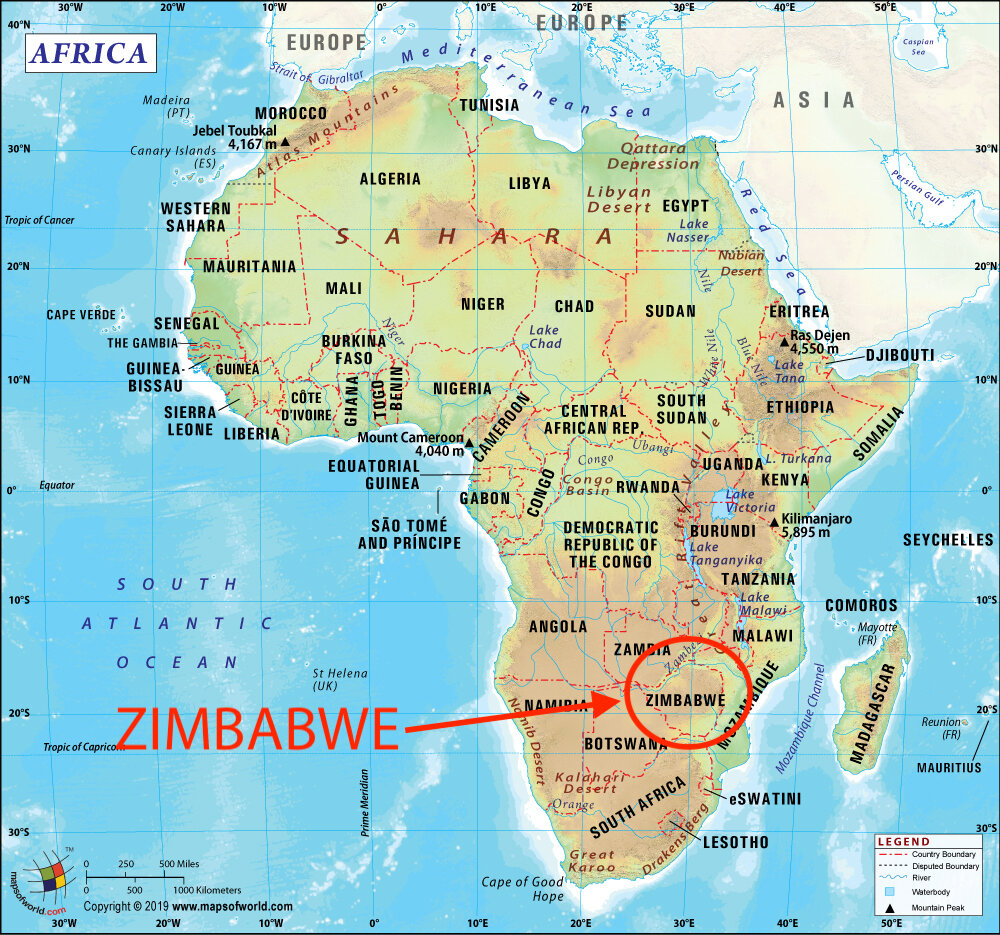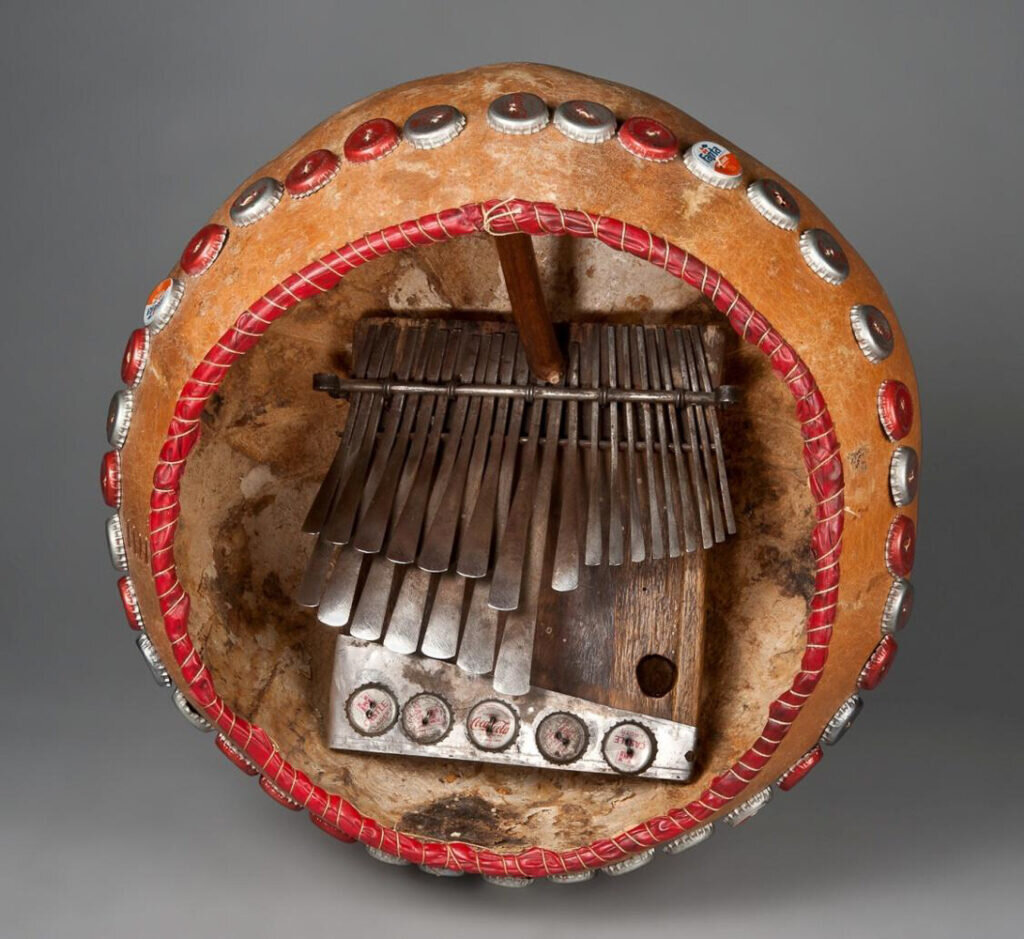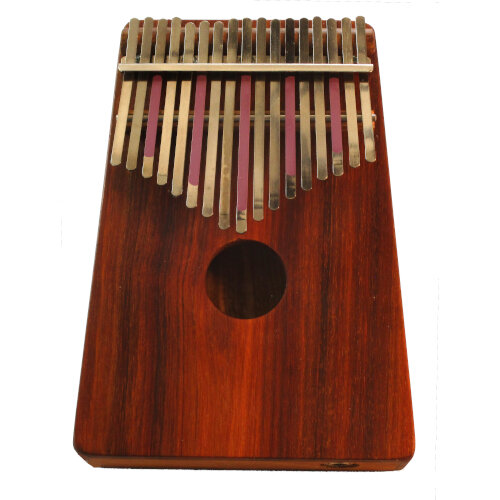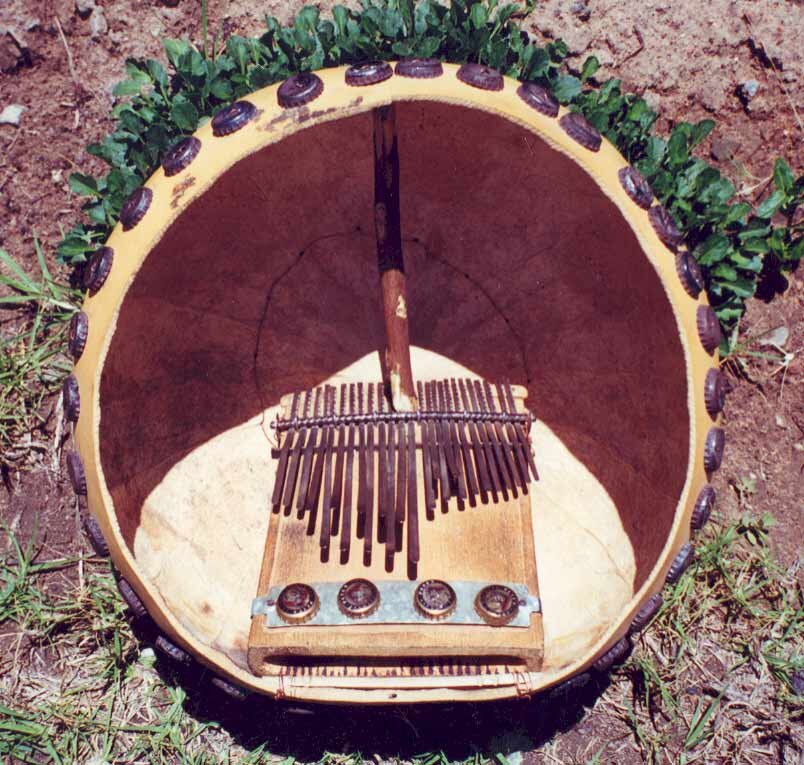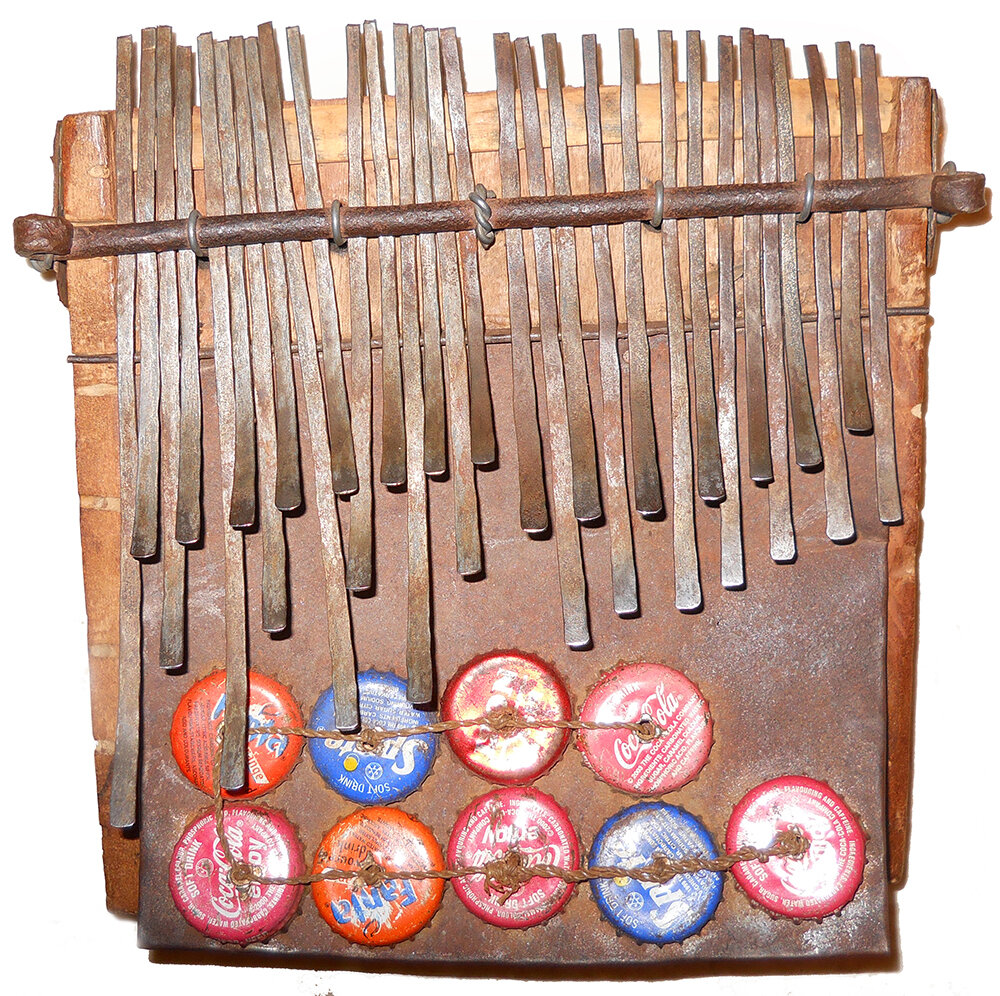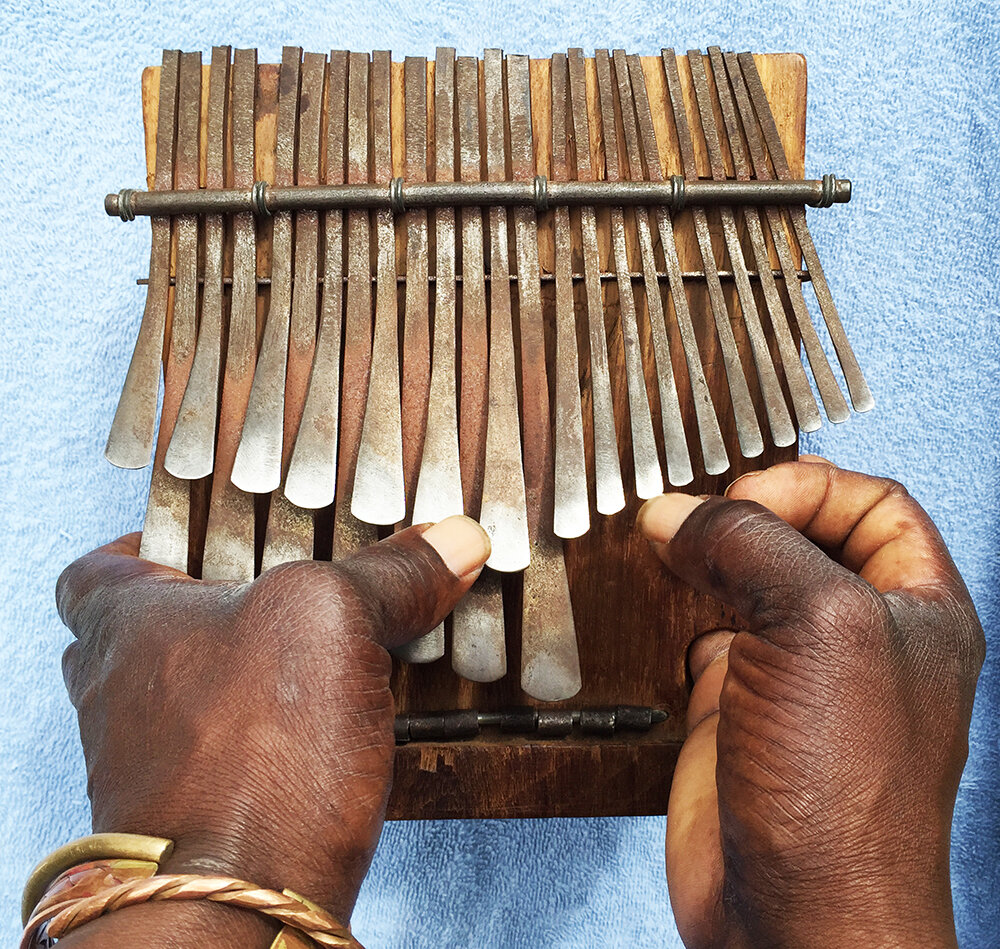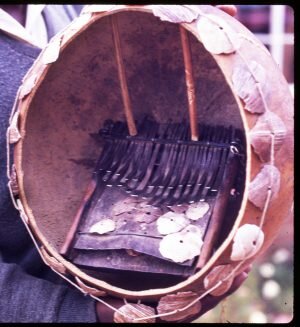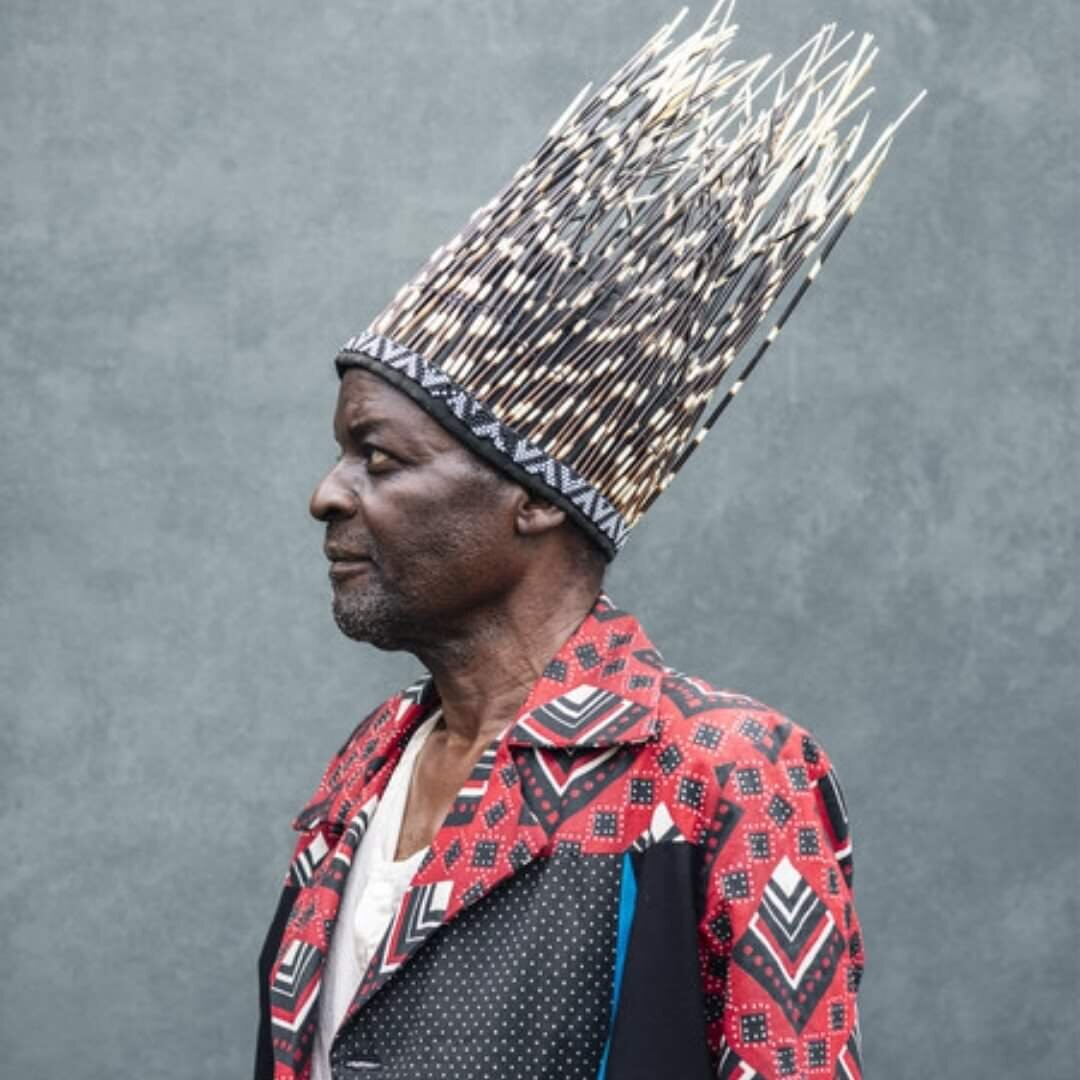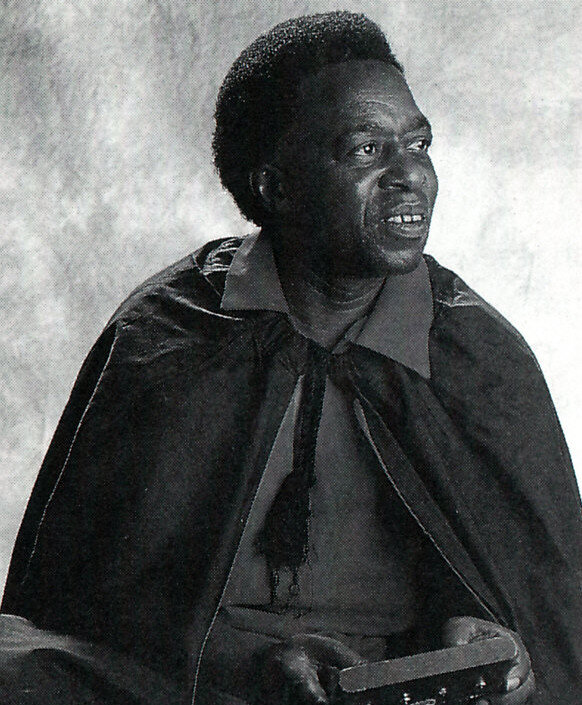Let’s begin by watching the following video. Mbira (pronounced “mmm-BEErah”) music is likely very new to you. The MBIRA is a lamellophone or “thumb piano” developed by the Shona people who live in modern day Zimbabwe in southeast Africa). As you watch the video, consider some things:
Does this music sound at all familiar? What do you associate it with?
What purpose might this type of music serve?
In this video specifically: what is the connection between the instruments, singing, and dancing? Are there context clues from the music video that give you an idea of what the song might be about?
ORIGINS OF MBIRA
A lamellophone is a unique family of instruments in the larger grouping of percussion. Whereas MEMBRANOPHONES are drums (the sound caused by vibrating membranes like drum heads) and the STRUCK IDIOPHONES are mallet keyboard instruments (where the bars of marimbas or xylophones ring when beaten by a mallet), the LAMELLOPHONE features a lamella or “tongue” made of metal or another hard material that rings when plucked - most often by the thumb or finger. Many lamellophones have a kind of resonator box or bowl to amplify the sound of the vibrating lamella - otherwise the sound would be similar to that of a plucked rubber band.
The MBIRA is a lamellophone comprised of metal lamella adhered to a wooden resonator box. This box is then secured into a large, hollow gourd that serves as an even fuller resonating chamber. Many Mbira are covered with a number of shells, bottle caps, or other small hard items that create a shimmering rattle effect with the instrument is played - this will be discussed in further detail later on this page. Mbira come in all shapes, sizes, and constructions depending on their region and purpose of use.¹
The video below shows a close-up view and describes the construction and layout of a typical Mbira:
SHONA or ZIMBABWEAN?
The Mbira is an instrument developed by the Shona people who have become synonymous with modern day Zimbabwe. Zimbabwe is a country in southeast Africa that was established in 1980. Prior to 1980, the region of Zimbabwe endured over a century of English occupation. The geo-political history of the continent of Africa is complex and marred by European colonialism.
From 1200 - 1450, the area flourished as the Kingdom of Zimbabwe with a capitol city of Great Zimbabwe. For the next several hundred years, various kingdoms fell and rose to power as a reflection of resources and trade throughout the region. From 1889 - 1965, the region was a British mining colony called Rhodesia. In 1965, the white minority government ceded from England in an attempt to maintain control over the country. The decade of the 1970’s saw civil unrest as the indigenous Zimbabweans fought for liberation, eventually declaring independence as the sovereign nation of Zimbabwe in 1980.²
All this goes to say that we must draw a distinction between the Shona people (who developed the traditional Mbira and its performance practices) and the demographics of modern-day Zimbabwe (that is approximately 70% ethnically Shona).³
A SACRED PURPOSE
http://gemnation.co.zw
While Mbira can be played secularly (for individual or group enjoyment), the most sacred ceremonies of Shona religious practices involve Mbira performance. A GWENYAMBIRA, or mbira player, is considered in some ways to be a priest or priestess. While most Gwenyambira through history have been men, occasionally, women in family lines with strong mbira playing have been called as Gwenyambira in addition to their male counterparts.
The playing of the Mbira and accompanying song is meant to be a prayer to a family or tribe’s ancestors (called VADZIMU), asking for support or guidance, or bestowing honor or thanks. This ceremony is called a MABIRA. The shimmering of the shells or bottle caps on an Mbira is a sound meant to rouse the Vadzimu while a Gwenyambira often goes into a trancelike state when performing. Song and dance rituals involving the Mbira can often last up to twelve hours and go all night long with many tribal members participating in song, instrumental music, or dance.⁴
MUSIC OF THE CHIMURENGA
“Shumba” - Thomas Mapfumo (1986)
Since the late 19th century, colonizing forces had spent a great deal of energy assimilating native Zimbabweans to European culture, including outlawing the playing of Mbira or participating in other cultural and spiritual rituals of African song and dance. By the mid-20th century, there were very few Gwenyambira left as assimilation to European culture all but eradicated this indigenous tradition. Shona people were converted to Christianity and taught that their traditional practices - including the playing of Mbira - were satanic practices.⁵
During the 1960 - 1970’s, when the Zimbabwean people began to resist European occupation and seek independence, a protest movement and music genre arose called the SECOND CHIMURENGA. The word Chimurenga roughly translates as “revolutionary struggle”. The musical movement was lead by THOMAS MAPFUMO (b. 1945) and was characterized by lyrics calling for political reform, social justice, and the end of white rule over Zimbabwe. Even though this musical genre did not include Mbira, Mapfumo modeled the textures of the electric guitar to reflect Mbira performance styles. Once Zimbabwe was liberated in 1980, the region saw a new interest and resurgence in traditional Mbira playing, although counteracting the longterm effects of colonials has been a multi-generational effort.
Today, the Zimbabwean government and members of society (as well as global cultural support groups) are helping to end the colonial stigma against traditional instruments such as the Mbira and reintroduce it to the youngest generation of Zimbabwean children.
OTHER LAMELLOPHONES
The Mbira is actually a family of instruments with the Kalimba being an instrument that could be considered a close cousin.
KALIMBA/KARIMBA: The Kalimba is a small, modern version of the Mbira with a single row of lamella and often in a seven-note diatonic scale. The Kalimba also does not use a gourd as a resonator. Many people use the words “Kalimba” and “Mbira” interchangeably but there is a difference!
MATEPE: This instrument serves a similar purpose to the Dzavadzimu but was developed in a northern region of Zimbabwe.
MBIRA DZAVADZIMU: This is the full name for the instrument described above. The name translates to something like “mbira of the ancestors” and is specifically used in the Mabira ceremony to summon ancestors for guidance.
MBIRA DZAVANDAU: This instrument is performed on by men of the Ndau tribe. Although similar in construction to the Dzavadzimu, it is performed solo for secular purposes only.
NHARE: This instrument has approx. 24 lamella and was used to communicate directly with the Shona deity (translating as “the call”) although it is less commonly played today.
NJARI: This is a 30-32 lamella instrument that originated in Mozambique
Kalimba (https://www.kalimbamagic.com/)
Matepe (https://en.wikipedia.org/w/index.php?curid=20720846)
Mbira Dzavadzimu (http://gemnation.co.zw)
Mbira dzaVaNdau (https://mbira.org)
A Possible Nhare (https://mbira.org)
Njari (https://mbira.org)
Visit https://mbira.org/ to hear audio of the different varieties of southeastern African lamellophones.
OTHER INSTRUMENTS
While Mbira is sometimes played as a solo instrument (or as an instrument to accompany voice or voices), it can be played in larger instrumental ensembles consisting of multiple Mbira or other traditional African instruments such as:
HOSHO: seed-filled rattles
MAGAGA: anklet rattles that provide a percussive beat from the dancers
MAKWA: wooden clappers (similar to clave from South America or Australian clapsticks)
NGOMA: drums made from taught animal hide - the smaller are struck with the hand and the larger are beaten with sticks
MBIRA TRAINING
Mbira music is an aural tradition with no written notation. Students of the mbira learn from older musicians who pass specific pieces as well as styles and improvisation techniques down. Unlike many aural music traditions, the teacher-student relationship is loose. In many cases, students are expected to absorb or “pick up” musical technique simply by observing the teachers perform rather than receiving specific instruction. In addition, it is common for mbira students to learn from many teachers (one after another or intermixed) and receive just a few “lesson” sessions from each rather than studying with a single teacher for many years. Musicians improve themselves through rote memorization, consistent repetition, and developing improvisation techniques.⁶
MUSICAL ELEMENTS OF MBIRA …
RHYTHM: While there is great variety, Mbira music tends to be in a symmetrical meter (simple, compound, or in hemiola layers of both) and at a medium-fast tempo that promotes ease of song and dance accompaniment.
MELODY: Mbira have a fixed number of lamella (usually between 13 - 28) and are constructed to play in a single pentatonic (5-note) or diatonic (7-note) scale over a range of a few octaves. Modern/hybrid Mbira exist that can play all the chromatic notes of the piano although these instruments are not used in traditional performance. Depending on where in the scale the performer centers the melody, Mbira can play in both major or minor. The melodies of Mbira usually sound like some outline of ARPEGGIOS (a musical term for a broken-up chord where each note of the chord is heard individually rather than performed at once in harmony).
HARMONY: With two thumbs, a single Gwenyambira can play two notes at a time, resulting in a “duet” effect if desired or creating more intricate harmonies between the melody and other notes within the scale. The harmonies, when present, are almost always consonant and a piece of mbira music may move back and forth between solo melody and melody with harmony. As outlined above, chords can be heard outlined one note at a time with an effect called an arpeggio.
TIMBRE: The timbre of the mbira is shimmery, round, and clear. Depending on the inclusion of shells, bottle caps, or other rattle-like objects, certain Mbira have a buzzy, almost abrasive quality at the beginning/attack of the sound.
DYNAMICS: By plucking the lamella harder or softer, one can achieve a narrow range of dynamics, though a single mbira usually centers into a medium-soft (mp) to medium-loud (mf) volume. With the addition of multiple Mbira, other instruments, and voices, the dynamic range of a larger ensemble increases.
TEXTURE: There is often a clear melody (sung or played in the upper range of the mbira) making much mbira music melody-accompaniment homophonic. However, in some cases, the complex layers of mbira playing - especially when multiple instruments are performed at once - can make some songs more polyphonic with multiple independent lines layered into a single piece of music.
FORM: A single piece of mbira music is often strophic with a repetitive pattern throughout the piece. Mbira music lends itself well to improvisation so while a standard form may be established at the beginning of a song, oftentimes, players will improvise or make music up within the
THE UNIFORM
There is no standard uniform for performing on an mbira. Depending on the event and reason for performing, Gwenyambira may wear street clothes, formal attire, or traditional cultural/religious garments. The traditional clothing may include a wrapped robe or dress made of cloth, grasses, or animal skin, a headdress often made from feathers or porcupine quills, and jewelry - though this can vary greatly from region to region.
Chartwell Dutiro, Gwenyambira
Dumisani “Dumi” Maraire
FAMOUS GWENYAMBIRA
CHIWONISO MARAIRE (USA)
DUMISANI “DUMI” MARAIRE (Zimbabwe)
OLIVER MTUKUDZI (Zimbabwe)
STELLA CHIWESHE (Zimbabwe)
TENDAYI GAHAMADZE (Zimbabwe)
MBIRA dzeNHARIRA (Mbira Ensemble)
WHERE TO HEAR MBIRA IN THE USA
African Cultural Events
Some Colleges (Eastman School of Music, Duke University)
Zimbabwe Music Festival (ZimFest - Evergreen State College, Olympia, WA)
The Kutsinhira Center (Eugene, OR)
SUPPLEMENTAL VIDEOS
In Spring 2020 and Fall 2020, we welcomed two virtual guests to MUSC106 to speak to the class about the Mbira and the history of Shona music. Their taped lectures are below. This is not required reading/viewing for Spring 2021 but if you are especially interested in the topic, the videos are wonderful and I encourage you to check them out!
Fall 2020 Guest Lecture with Dr. Mhoze Chikowero
Dr. Mhoze Chikowero (an African music scholar and professor at University of California at Santa Barbara) shares his research and book with the Pierce College Fall 2020 MUSC106 class. We learn about the mbira instrument, its cultural significance to the Shona people, and the effects of colonization on Zimbabwe with especial emphasis on the destruction of musical culture.
Spring 2020 Guest Lecture (and Mbira Performance)
with Professor Tanyaradzwa Tawengwa
Professor (now Dr.!) Tanyaradzwa Tawengwa (an mbirist, composer, and singer) shares her family history with Pierce College Spring 2020 MUSC106 class. We learn about the mbira instrument, Dr. Tawengwa’s path to embracing the mbira, and are treated to a beautiful performance.
To hear Professor Tawengwa perform on the mbira, click to the following timestamps:
31:40
43:00
50:20


